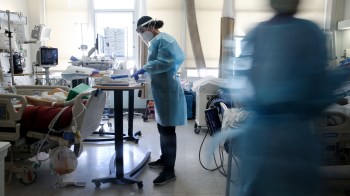Data: The secret ingredient in hospital cooperation
If you’ve got to go to the hospital – one that’s near your home or very far from it – you’d want your prescriptions, past procedures, and all the rest at your doctor’s finger tips.
And while sharing that kind of data could reassure consumers and save perhaps as much as $80 billion a year, it remains a fantasy for most patients.
“Everybody in the medical field knows there are economies to be gained there if we would just work together and share the information,” says former Beth Israel Deaconess Medical Center CEO Paul Levy. “And yet the industry, for the most part, is dead set against doing that.”
After nearly ten years running one of the premiere institutions, Levy says he came to see that hospital executives don’t trust each other enough to work together. But what is out of reach for most patients in America is becoming a reality in one of America’s poorest and most troubled cities, Camden, New Jersey.
It’s a potential blueprint, say executives involved in the program.
“You get three health systems to come together who are competitors who on Monday, Wednesday and Friday want to kill each other in the marketplace, but on Tuesday and Thursday are putting together a coalition that is taking better care of patients at lower costs,” says Dr. Anthony Mazzarelli, a Senior Vice President at Cooper University Health System in Camden.
Cooper, Our Lady of Lourdes Hospital and the Virtua health system have all agreed to share patient data on the city’s 30,000 residents enrolled in Medicaid. They’re doing that through what’s called a health information exchange – or HIE.
The Virtua Health Systems building. (Photo: Jessica Kourkounis)
The value, says Virtua attorney Deborah Mitchell, is that doctors and hospitals can track who is where, when they are there, all in real time.
“Now a doctor will know, ‘This patient was at Cooper yesterday, now why are they are Virtua’s ER today? What’s happening with this patient?’” she says.
To put Camden in context, there are only 119 HIEs around the country and they’re generally more limited. University of Michigan health policy professor Julia Adler-Milstein explains for most of us our information may be shared with some doctors and hospitals.
For Medicaid patients in Camden the HIE involves virtually every health provider.
“Is what is happening in Camden in the best interest of their patients?” Adler-Milstein says. “You would say yes. You go to most other places, you would say no.”
Adler-Milstein says it’s hard to criticize hospitals and physicians. After all, she says, they’re just following the economic incentives they see.
In that way, Camden’s hospital executives are no different.
“The common denominator is we all can kind of win,” says Cooper’s Mazzarelli.
What’s different in Camden is data.
Long before the HIE, Dr. Jeff Brenner began tracking some of the city’s sickest and most expensive patients, the patients hospitals had lost money on for decades. And he told docs and executives often mesmerizing and horrific stories — like one guy who had 300 emergency room visits in a year.
“I mean there’s only 365 days,” says Mazzarelli. “I think before this every health system thought they were carrying the burden and now you realize, ‘Wait, wait, we are all carrying this unbelievable burden on the same patients.’”
Those stories cracked opened the door to modest data sharing in the city. And that helped the hospitals get their arms around the problem.
Pretty soon, Kim Barnes, with Our Lady of Lourdes, says everybody could see it was in their economic best interest to share patient data, at least on their Medicaid patients.
“You realize that problem is going to be solved by partnering, by developing better transitions and handoffs among providers,” she says. “Those pictures are painted very clearly when you see the data.”
What took Camden so long to do might be quicker in San Diego, Kansas City and Miami as incentives move and more and more providers get paid to keep costs down.
Mazzarelli predicts that’ll be enough to get hospital executives over the hump to break bread with their competitors.
“Executives, I think – and I can say this, being one myself – I think we look at where our incentives lie,“ he says. “I wish that shifting the incentives of how people get paid didn’t change things in our healthcare system, but it’s becoming pretty clear it probably will make a difference.”
Executives at all three Camden hospitals say they imagine a day soon when they’ll exchange data for all their patients. Mazzarelli says the incentive undertow is so strong that the patients the hospitals have gone to war over for decades – gold-plated privately insured patients – are now more valuable as something shared than something guarded.
Cooper University hospital. (Photo: Jessica Kourkounis)
This ongoing series on healthcare and data is produced in partnership with Healthy States.
There’s a lot happening in the world. Through it all, Marketplace is here for you.
You rely on Marketplace to break down the world’s events and tell you how it affects you in a fact-based, approachable way. We rely on your financial support to keep making that possible.
Your donation today powers the independent journalism that you rely on. For just $5/month, you can help sustain Marketplace so we can keep reporting on the things that matter to you.


















